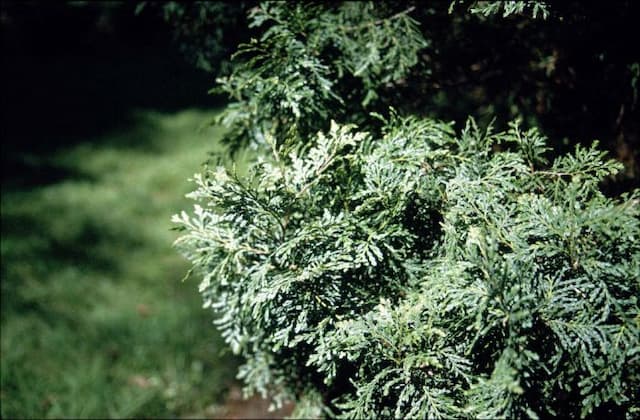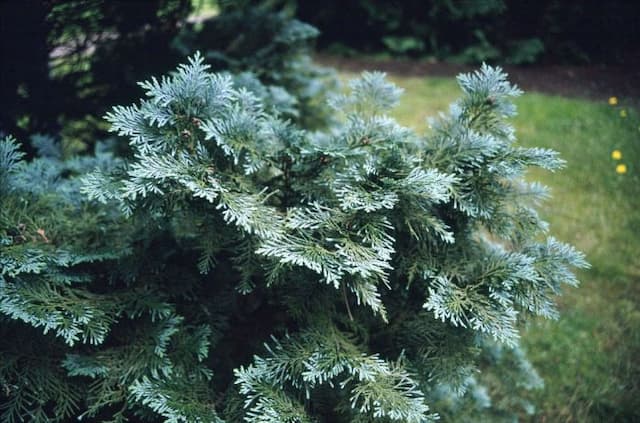Lawson's Cypress Chamaecyparis lawsoniana 'Ellwoodii'











ABOUT
The Port Orford cedar 'Ellwoodii' is a coniferous evergreen shrub known for its attractive, columnar growth habit and dense, fine-textured foliage. This plant's leaves are arranged in flattened sprays, presenting a soft blue-green hue that remains consistent through the seasons. The delicate leaves closely overlap each other and may have a somewhat scaly appearance that makes the plant particularly appealing for ornamental purposes. As a variety of Port Orford cedar, 'Ellwoodii' features the same scale-like leaves as its parent species, but with a unique form that sets it apart in terms of visual interest. The foliage may also emit a pleasant aroma when brushed or crushed. Its compact nature and slow growth rate make it a popular choice for creating focal points in landscape designs, offering a touch of elegance and evergreen beauty throughout the year.
About this plant
 Names
NamesFamily
Cupressaceae
Synonyms
Ellwood's Lawson Cypress, Ellwood's Blue Cypress, Ellwoodii Lawson Cypress
Common names
Cupressus lawsoniana 'Ellwoodii', Chamaecyparis lawsoniana 'Ellwood's Pillar'.
 Toxicity
ToxicityTo humans
The plant commonly known as the Lawson's Cypress is not known to be highly toxic to humans. It does not typically cause serious poisoning when ingested. However, handling the plant may sometimes cause skin irritation or allergic reactions in sensitive individuals due to the naturally occurring oils and compounds in the foliage.
To pets
The Lawson's Cypress is generally considered to have a low level of toxicity to pets. If ingested, the plant may cause mild gastrointestinal upset including vomiting or diarrhea in some animals. While serious poisoning is rare, it is advisable to prevent pets from ingesting this plant to avoid any potential discomfort or reactions.
 Characteristics
CharacteristicsLife cycle
Perennials
Foliage type
Evergreen
Color of leaves
Blue-green
Height
6-8 feet (1.8-2.4 meters)
Spread
2-3 feet (0.6-0.9 meters)
Plant type
Shrub
Hardiness zones
5-8
Native area
North America
Benefits
 General Benefits
General Benefits- Ornamental Value: The plant, commonly known as Lawson's Cypress 'Ellwoodii', offers attractive, columnar growth with blue-green foliage, making it a beautiful addition to gardens and landscapes.
- Low Maintenance: This cultivar typically requires minimal pruning and care once established, making it suitable for many gardeners, including beginners.
- Drought Tolerance: Once established, Lawson's Cypress 'Ellwoodii' can tolerate periods of drought, reducing the need for frequent watering.
- Privacy Screen: With its dense foliage and upward growth, it can provide privacy and act as a living screen when planted in rows.
- Wildlife Habitat: The dense foliage offers shelter to birds throughout the year, while its scale-like leaves provide nesting material for some species.
- Adaptable to Soil Types: It can thrive in a range of soil types, provided the soil is well-drained, making site selection easier for planting.
- Year-Round Interest: Lawson's Cypress 'Ellwoodii' is an evergreen, ensuring that it provides color and structure to a garden throughout every season.
- Windbreak: When planted in groups, it can act as an effective windbreak, protecting gardens and buildings from strong winds.
 Medical Properties
Medical PropertiesThis plant is not used for medical purposes.
 Air-purifying Qualities
Air-purifying QualitiesThis plant is not specifically known for air purifying qualities.
 Other Uses
Other Uses- Miniature Landscaping: Lawson Cypress 'Ellwoodii' can be used to create miniature landscapes or fairy gardens due to its small size and slow growth habit.
- Bonsai: This plant lends itself well to the art of bonsai due to its fine foliage and ability to tolerate pruning and shaping.
- Model Railroading: Hobbyists who create model railroads use Lawson Cypress 'Ellwoodii' to fashion realistic trees and forest scenes on their layouts.
- Therapeutic Horticulture: Engaging with Lawson Cypress 'Ellwoodii' through the practices of pruning, potting, and maintaining can provide therapeutic benefits, such as reduced stress and improved mental wellness.
- Screening: In outdoor spaces or gardens, Lawson Cypress 'Ellwoodii' can be planted in rows to create natural privacy screens due to their dense growth habit.
- Crafts: The fine foliage and wood of Lawson Cypress 'Ellwoodii' can be used in crafts, such as wreath making, providing a unique texture and fragrance.
- Photography: Nature photographers sometimes use Lawson Cypress 'Ellwoodii' as a subject or as a backdrop for macro photography, capturing its intricate leaves and growth patterns.
- Educational Tool: This plant can be used in schools and educational programs to teach students about botany, plant care, and the importance of conifers in ecosystems.
- Festive Decoration: During the holiday season, Lawson Cypress 'Ellwoodii' can be decorated with small ornaments and lights to be used as a live Christmas decoration.
- Contest & Exhibitions: Enthusiasts may grow Lawson Cypress 'Ellwoodii' for conifer exhibitions and competitions, aiming to cultivate a specimen of notable beauty or form.
Interesting Facts
 Feng Shui
Feng ShuiThe Lawson's Cypress is not used in Feng Shui practice.
 Zodiac Sign Compitability
Zodiac Sign CompitabilityThe Lawson's Cypress is not used in astrology practice.
 Plant Symbolism
Plant Symbolism- Longevity: As an evergreen, the Lawson Cypress or 'Ellwoodii' symbolizes long life and immortality, reflecting its ability to remain green and vibrant throughout the seasons.
- Endurance: Its hardy nature and resistance to harsh conditions make it a symbol of endurance and the ability to withstand challenges.
- Sanctuary: With its dense foliage and upright growth, this plant is often associated with safety and provides a feeling of sanctuary and protection.
- Purity: The Lawson Cypress is also linked to purity, thanks to its clean, fresh scent and often pristine green appearance, conveying a sense of cleansing and renewal.
- Peace: Its calm and soothing presence is believed to bring peace and tranquility to a garden or landscape, making it a symbol of serenity.
 Water
WaterThe Lawson's Cypress 'Ellwoodii' prefers moist soil and should be watered regularly to maintain consistent moisture levels, avoiding both overwatering and allowing the soil to completely dry out. This typically means watering once or twice weekly, supplying around 1 to 2 gallons of water during each session depending on weather conditions. During hot or windy weather, you may need to water more frequently, but always check the soil moisture several inches below the surface before adding water. In the winter, when the tree is dormant and evaporation rates are lower, reduce watering frequency.
 Light
LightLawson's Cypress 'Ellwoodii' thrives in full sun to partial shade. The ideal spot for the plant would have access to at least four to six hours of direct sunlight each day, though it will also do well in spots that receive filtered light or afternoon shade. Avoid deep shade conditions as this can result in sparse foliage and a less robust form.
 Temperature
TemperatureLawson's Cypress 'Ellwoodii' is hardy and can tolerate a wide range of temperatures, typically surviving in zones 5 to 8. The ideal temperature conditions for this plant are generally between 40 to 70 degrees Fahrenheit. It can endure temperature extremes down to 20 degrees Fahrenheit but at the risk of damage from prolonged cold snaps.
 Pruning
PruningPrune the Lawson's Cypress 'Ellwoodii' to maintain its desired shape and to remove any dead or damaged branches. The best time for pruning is in the late winter or early spring before new growth begins. Pruning is not required frequently; once a year or every other year is typically sufficient, focusing on light shaping and thinning as needed.
 Cleaning
CleaningAs needed
 Soil
SoilLawson's Cypress 'Ellwoodii' thrives in well-draining, moist soil with a slight acidity, preferring a pH range of 5.5 to 7.0. A mixture of peat, sand, and loamy soil can create the ideal environment for this conifer.
 Repotting
RepottingLawson's Cypress 'Ellwoodii' typically doesn't require frequent repotting and can be done every 2 to 3 years, or when it outgrows its current container.
 Humidity & Misting
Humidity & MistingLawson's Cypress 'Ellwoodii' prefers moderate to high humidity levels but is adaptable to a variety of humidity conditions as long as it's not too dry.
 Suitable locations
Suitable locationsIndoor
Ensure bright light, cool temperatures, and rotate for even growth.
Outdoor
Plant in well-drained soil, full sun to partial shade.
Hardiness zone
5-8 USDA
 Life cycle
Life cycleThe Lawson's Cypress 'Ellwoodii' begins its life as a seed, sprouting to develop a root system and a shoot that emerges from the soil. As a seedling, it establishes itself and starts to develop foliage that is characteristically dense and conical in shape. In the juvenile stage, 'Ellwoodii' grows quickly and its leaves present as soft, blue-green scales. Reaching maturity, it may slow in growth rate and develop into a columnar or narrowly conical form, which is often used in ornamental horticulture. Throughout its life, the plant will undergo seasonal cycles of growth and may produce small cones if the conditions allow for sexual reproduction. Lastly, as with all plants, Lawson's Cypress 'Ellwoodii' eventually ages, its growth rate diminishes, and it will enter senescence before dying, completing its life cycle.
 Propogation
PropogationPropogation time
Early spring
The most popular method of propagating the Port Orford cedar, scientifically known as Chamaecyparis lawsoniana 'Ellwoodii', is by cuttings. This technique is carried out in late summer to early fall, when semi-hardwood cuttings from the current year's growth are most likely to root successfully. To begin, you should select a healthy shoot around 4 to 6 inches (10 to 15 centimeters) long, cutting it just below a node, as this is where the concentration of rooting hormones is highest. Remove the lower one-third of the foliage to prevent excess moisture loss and dip the cut end into a rooting hormone powder to encourage root development. The prepared cutting should be inserted into a pot filled with a well-draining potting mix, such as one part peat to one part perlite. The pot needs to be kept moist and in a warm area with indirect light. Roots typically start to form within a few weeks, after which the young plants can eventually be potted on or planted out into their permanent positions.









